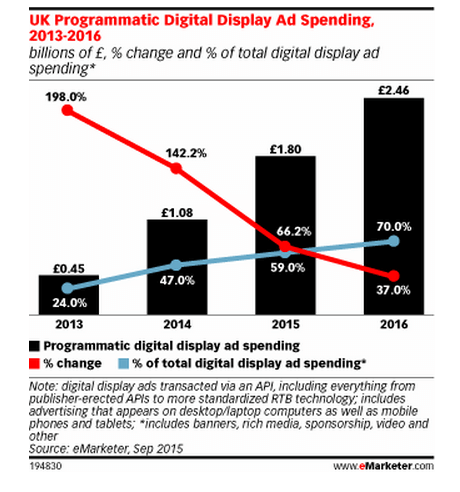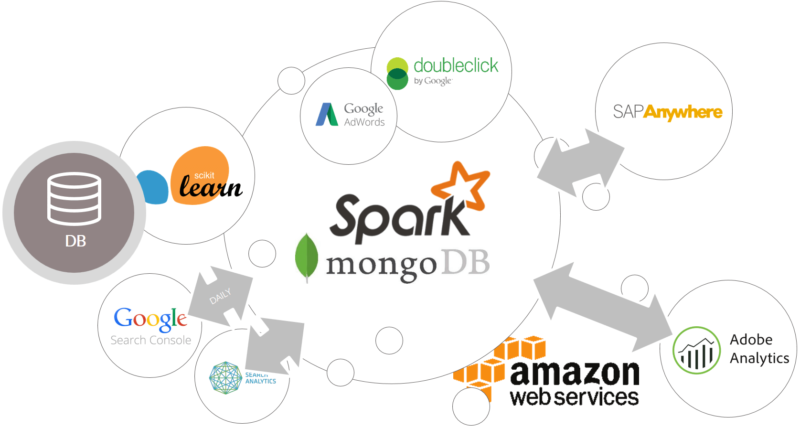Connect audience insight to your SEO strategy
Columnist Chris Liversidge believes that audience enrichment data is key to making better optimization decisions and that search marketers should be ready to engage with an audience-led strategy.

Audience enrichment — combining first-party data from your website with third-party data gathered from other sources to get a more complete picture of your visitors — is a hot topic right now amongst enterprise-level businesses.
Evidence of its impact is clear in channels such as programmatic, which continues to rampage through paid marketing budgets, hoovering up the dollars left and right.

eMarketer UK Programmatic Digital Display Ad Spend 2016
Being UK-based, the above overview from eMarketer struck a chord on that progress to channel dominance for programmatic within paid channels. But you can also take a look at the dominant player in audience data (Facebook) to see the impact this transition has had on its overall revenues and see where much of this spend is happening: mobile.

Facebook Mobile Revenue Marketshare Q1 2016
Paying for third-party audience data (via Atlas, say, to integrate Facebook’s audience data with your first-party site data) is a common tactic within programmatic and paid social. But less common is then leveraging that audience data to improve your other digital marketing channels.
Most clients I speak to are very early on in their path to adopting a truly audience-first multichannel strategy, and one of the big gap areas is connecting search engine search intent to individual customers identified through audience enrichment strategies. (On mobile, that gap is even wider.)
For example, it is very common to identify different points in the purchase path in SEO by walking down the long tail and grouping up terms with semantic meaning that align with stronger “buy” intention, but it is also possible to align that intent-led strategy with our rich audience data to understand who our organic searcher is (in an anonymized way) and what their needs and wants are actually likely to be.
So, how can we marketers match that intent to audience data and integrate ourselves into the mix? It’s clear that audience-led strategy is the future of multichannel marketing, and without closing this gap, SEOs — and, to a lesser extent, traditional paid marketers — are going to be left in the passenger seat when it comes to driving strategy.
Study your audience to know their behavior
Up until a few years ago, closing the gap between individual audience identification (anonymously, or as part of a wider cohort) and actual channel-specific strategy was nearly impossible. It required you to align your various data silos to draw careful lines between sessions and intuit connections, lightening the load where you could with statistical “bridge-building” and extrapolating up from very small data sets (comparatively).
Today, the infrastructure is cheap enough and the tool kits are advanced enough — particularly in the area of machine learning — that you can build your own data analysis stack and brute-force the individual audience solution yourself.
For example, the illustration below shows how the basic components would look for a data analysis stack that could leverage machine learning to create those connections between individual customer behaviors and your myriad marketing channels for you.

Audience Behaviour Multichannel Data Stack Simplified 2016 c/o QueryClick.com
Once that bridge has been crossed, you can merrily hook up your historic data and walk back along transaction timelines to determine the true lifetime value of that customer, then collect up their attributes into a high-value cohort for use influencing your marketing collateral, calls to action and budget prioritization across all your channels.
So, what have we done here to connect the dots between mobile SEO data and rich audience data from elsewhere?
Well, in a sense, we have simply performed a nearly infinite number of A/B tests on the data to know that the person clicking through that mobile organic result at a particular instant was the same person who saw your sponsored Facebook post yesterday at lunchtime and who saw the London underground poster campaign you ran last month.
We also know they will respond well to landing page content that emphasizes utility and ease of use, over and above price; and as a premium brand, we know we should nudge our title and meta description information to highlight these features, advantages and benefits for their expected next touch point via generic mobile voice search.
To execute on that kind of insight, we need a platform environment that allows tweaked HTML information for mobile vs. desktop or tablet. We also need to go further when it comes to the data being analyzed within the sphere of SEO. For example, the Search Console, though it gets a bad rap from many commentators, is a fantastic tool in this audience-led environment — and Google very much knows this, if their marketing collateral is any indication — because we can assess the value of lost customers who saw but never clicked on our listing at all.
When we put that insight within the context of a multichannel conversion path that contains many highly important touch points throughout, it’s easy to see how looking at just the existing rank data is insufficient when assessing audience engagement against expectation for their cohort.
I expect to see most businesses employ a data stack similar to the above (which is highly simplified), with multiple audience enrichment data sources (e.g., Atlas) in the very near future. And as search marketers, we should be ready to engage with the audience-led strategy we can build from it.
Contributing authors are invited to create content for Search Engine Land and are chosen for their expertise and contribution to the search community. Our contributors work under the oversight of the editorial staff and contributions are checked for quality and relevance to our readers. The opinions they express are their own.
Related stories
New on Search Engine Land